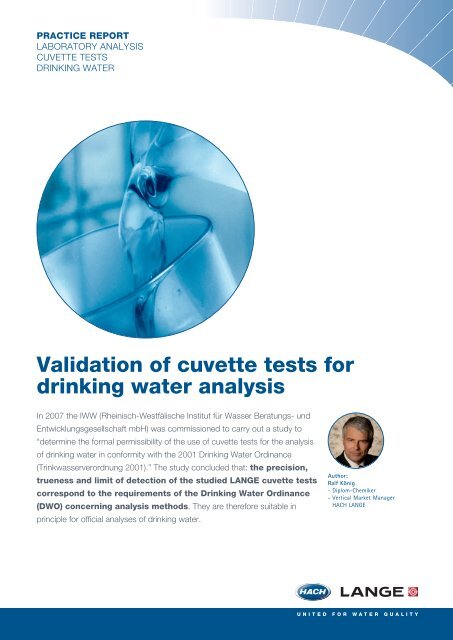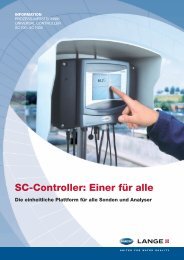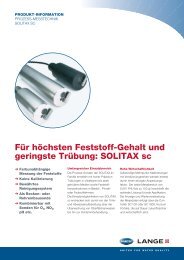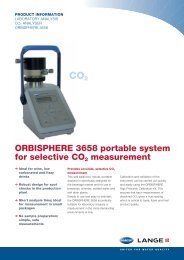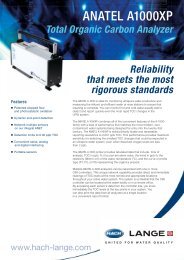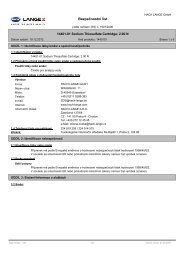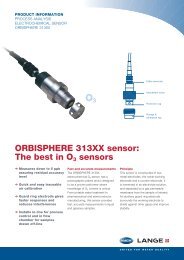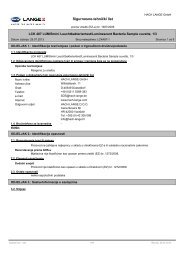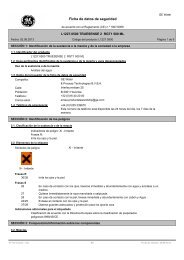Validation of cuvette tests for drinking water analysis - HACH LANGE
Validation of cuvette tests for drinking water analysis - HACH LANGE
Validation of cuvette tests for drinking water analysis - HACH LANGE
- No tags were found...
Create successful ePaper yourself
Turn your PDF publications into a flip-book with our unique Google optimized e-Paper software.
PRACTICE REPORTLABORATORY ANALYSISCUVETTE TESTSDRINKING WATER<strong>Validation</strong> <strong>of</strong> <strong>cuvette</strong> <strong>tests</strong> <strong>for</strong><strong>drinking</strong> <strong>water</strong> <strong>analysis</strong>In 2007 the IWW (Rheinisch-Westfälische Institut für Wasser Beratungs- undEntwicklungsgesellschaft mbH) was commissioned to carry out a study to“determine the <strong>for</strong>mal permissibility <strong>of</strong> the use <strong>of</strong> <strong>cuvette</strong> <strong>tests</strong> <strong>for</strong> the <strong>analysis</strong><strong>of</strong> <strong>drinking</strong> <strong>water</strong> in con<strong>for</strong>mity with the 2001 Drinking Water Ordinance(Trinkwasserverordnung 2001).” The study concluded that: the precision,trueness and limit <strong>of</strong> detection <strong>of</strong> the studied <strong>LANGE</strong> <strong>cuvette</strong> <strong>tests</strong>correspond to the requirements <strong>of</strong> the Drinking Water Ordinance(DWO) concerning <strong>analysis</strong> methods. They are there<strong>for</strong>e suitable inprinciple <strong>for</strong> <strong>of</strong>ficial analyses <strong>of</strong> <strong>drinking</strong> <strong>water</strong>.Author:Ralf König- Diplom-Chemiker- Vertical Market Manager<strong>HACH</strong> <strong>LANGE</strong>
2DRINKING WATER ANALYSIS_REQUIREMENTSDo your <strong>cuvette</strong> <strong>tests</strong> meet <strong>drinking</strong><strong>water</strong> legislation?AccreditationIn principle, non-standardised methods canbe included in the accreditation, if they havebeen proven to be suitable <strong>for</strong> the user andhave been validated accordingly. The characteristics <strong>of</strong> the <strong>analysis</strong> methodmust satisfy the requirements specified inAnnex 5 <strong>of</strong> the Drinking Water Ordinance.As well as the basic pro<strong>of</strong> <strong>of</strong> the suitability<strong>of</strong> the methods (e.g. through this study), alaboratory must also provide the simplifiedpro<strong>of</strong> that it satisfies the requirements withregard to the characteristics. The test method must be approvedby the accreditation body as part <strong>of</strong> theaccreditation process (ISO 17025) and mustbe included in the certificate (or the annex tothe certificate). In this context, pro<strong>of</strong> <strong>of</strong> the fitness <strong>of</strong>the method <strong>for</strong> the intended purpose mustbe provided (in accordance with section 5.4<strong>of</strong> ISO 17025). The necessary validation workmust be carried out by the laboratory and ifnecessary, the manufacturer <strong>of</strong> the method. The laboratory carries out the stipulatedinternal (control cards) and external qualityassurance (successful participation in roundrobin <strong>tests</strong>) <strong>for</strong> the method. Finally, compliance with the abovementioned requirements must be <strong>for</strong>mallyconfirmed or recognised by the notificationbody in accordance with section 15 (5) <strong>of</strong> theDrinking Water Ordinance.If these criteria are satisfied, there is no legalimpediment to the inclusion <strong>of</strong> <strong>cuvette</strong> <strong>tests</strong> inthe laboratory’s internal “method portfolio”.BackgroundIn Germany, <strong>of</strong>ficial analyses <strong>of</strong> <strong>drinking</strong><strong>water</strong> are regulated by law. Theymay only be carried out by speciallyauthorised, notified laboratories, usingmethods that are specified in con<strong>for</strong>mitywith the Drinking Water Ordinance. Asthe German Drinking Water Ordinance<strong>of</strong> 2001 almost completely embodiesthe content <strong>of</strong> the European DrinkingWater Directive, most <strong>of</strong> its conditionsand requirements apply in similar <strong>for</strong>min the other Member States <strong>of</strong> the EU.In contrast to the situation with regardto waste<strong>water</strong>, the <strong>drinking</strong> <strong>water</strong>legislation specifies no concretemethodological requirements. Inprinciple, any method that yieldssufficiently reliable results and whoseper<strong>for</strong>mance characteristics con<strong>for</strong>m tothose defined in Annex 5, section 15 <strong>of</strong>the Drinking Water Ordinance, can beused. The per<strong>for</strong>mance characteristics(PC) are trueness, precision and limit<strong>of</strong> detection, which are expressedas a percentage (in this case 10 %)<strong>of</strong> the limit value. Another, no lessimportant “authorisation criterion” isthe requirement that the alternativemethod must con<strong>for</strong>m to the generallyacknowledged technical standards.Also, a laboratory that wants touse <strong>cuvette</strong> <strong>tests</strong> as alternatives tostandardised methods must possessa valid accreditation in con<strong>for</strong>mity withDIN ISO 17025.Requirements concerningaccreditationIf no method is specified by the client,an <strong>analysis</strong> laboratory is obliged touse the most appropriate <strong>analysis</strong>methods [3]. These appropriatemethods must have been publishedeither in international, regional ornational standards or by reputabletechnical organisations, or in relevantscientific journals, or have been clearlydescribed by the manufacturer <strong>of</strong> themethods (e.g. <strong>cuvette</strong> <strong>tests</strong>).Methods developed or adopted by thelaboratory may also be used if theyare suitable <strong>for</strong> the intended use andappropriately validated. The client mustbe in<strong>for</strong>med about the method chosen.Basic validation <strong>of</strong> the <strong>cuvette</strong><strong>tests</strong>A test method is validated byexamining its:- measurement uncertainty- limit <strong>of</strong> detection and limit <strong>of</strong>quantification- selectivity- linearity- precision- trueness- ruggedness against externalinfluences (cross-sensitivities,influences in the sample matrix)Furthermore, the alternative methodshould give results that are sufficientlycomparable to those obtained usingthe corresponding standard method.www.hach-lange.com
3All measurements were carried outwith a <strong>HACH</strong> <strong>LANGE</strong> DR 5000 UV-VISspectrophotometer (see Fig. 1).The basic calibration was carried outusing calibration solutions preparedby <strong>for</strong>tifying matrix-free solutions(ultrapure <strong>water</strong>) with the analytes<strong>of</strong> interest [1]. Certified referencematerials were used to <strong>for</strong>tify theanalytes. The limit <strong>of</strong> quantificationwas determined by measuring tencalibration solutions with equidistantconcentration levels starting from thelowest concentration <strong>of</strong> the measuringrange <strong>of</strong> the <strong>cuvette</strong> test over 10 days.The total measuring range wasvalidated by measuring from two t<strong>of</strong>ive additional calibration solutions upto the highest concentration <strong>of</strong> themeasuring range.For the validation <strong>of</strong> the <strong>cuvette</strong><strong>tests</strong>, the basic calibration data wereevaluated and used to calculate thefollowing method specifications. Calibration function andper<strong>for</strong>mance characteristics,- Gradient (b, measure <strong>of</strong> sensitivity),- Intercept- Standard deviation <strong>of</strong> the residuals(s y , scatter <strong>of</strong> the measured valuesaround the line <strong>of</strong> regression)- Method standard deviation (s x0 ,absolute measure <strong>of</strong> the precision<strong>of</strong> the calibration)- Method variation coefficient (V x0 ,relative method standard deviation,relative measure <strong>of</strong> the precision <strong>of</strong>the calibration) Verification <strong>of</strong> the linearity and Determination <strong>of</strong> the limits <strong>of</strong>detection and quantification inaccordance with DIN 32645.In addition, the homogeneity <strong>of</strong> thevariances over the measuring range wasexamined.The per<strong>for</strong>mance characteristics werecalculated with “S<strong>of</strong>tware <strong>for</strong> thestatistical control <strong>of</strong> analytical data– SQS” (Version 1.51, Perkin Elmer,Rodgau-Jügesheim).Fig. 1: DR 5000 spectrophotometer withtouchscreen, rotational barcode measurementand automatic error detection <strong>for</strong> reliableevaluation <strong>of</strong> all <strong>LANGE</strong> <strong>cuvette</strong> <strong>tests</strong>No. Parameter <strong>LANGE</strong> <strong>cuvette</strong> test Standard Measuring range <strong>of</strong> DWO limit value PC (%) PC (mg/l)<strong>cuvette</strong> test1 Aluminium LCK301DIN ISO 10566 0.02–0.5 mg/l 0.2 mg/l 10 0.02(Chromazurol S) (Pyrocatechol violet)2 Ammonium LCK304DIN 38406-50.02–2.5 mg/l 0.5 mg/l 10 0.05(Indophenol blue) (Indophenol blue)3 Chlorine, free LCK310DIN EN ISO 7393-2 0.05–2 mg/l min. 0.1 mg/l, - -(after disinfection) (DPD)(DPD)max. 0.3 mg/l4 Chlorine, total LCK310DIN EN ISO 7393-2 0.05–2 mg/l - - -(DPD)(DPD)5 Iron, trace LCK521DIN 38406 E1-1 0.01–1 mg/l 0.2 mg/l 10 0.02(1,10-Phenanthroline) (1,10-Phenanthroline)6 Manganese, trace LCW532DIN 38406 E20.005–0.5 mg/l 0.05 mg/l 10 0.005(PAN indicator)(Formaldoxim)7 Nitrate LCK339DIN38405 D9-1 1–60 mg/l 50 mg/l 10 5(2,6-Dimethylphenol) (2,6-Dimethylphenol)8 Nitrite, trace LCK541(Diazotisation)DIN EN 26777(Diazotisation)0.005–0.1 mg/l 0.5 mg/l, or 0.1 mg/lat <strong>water</strong> treatmentplant outlet10 0.019 Ortho-phosphate LCK349(Molybdenum blue)DIN EN ISO 6878(Molybdenum blue)0.15–4.5 mg/l 6.7 mg/l - -Table 1: Methodology, limit values and per<strong>for</strong>mance characteristics (PC) <strong>of</strong> the selected <strong>analysis</strong> parameters in con<strong>for</strong>mity with the 2001 DrinkingWater Ordinance (DWO)
4DRINKING WATER ANALYSIS_VALIDATION<strong>Validation</strong> <strong>of</strong> <strong>cuvette</strong> <strong>tests</strong>: precisionFig. 2: 5 cm rectangular <strong>cuvette</strong> <strong>for</strong> the precisedetermination <strong>of</strong> trace amounts <strong>of</strong> iron,manganese and nitriteV x0 (%)32,521,510,50LCK301 AluminiumMethod variation coefficients <strong>of</strong> <strong>cuvette</strong> <strong>tests</strong>PrecisionEvaluating the precision <strong>of</strong>the method using the methodvariation coefficientThe method variation coefficient(relative method standard deviation,V x0 ) is used to evaluate the precision<strong>of</strong> a calibration. The method variationcoefficient is a measure <strong>of</strong> the quality<strong>of</strong> a test method. Furthermore, itenables <strong>analysis</strong> methods with differentmeasuring ranges to be compared. The method variationcoefficients <strong>of</strong> the examined<strong>cuvette</strong> <strong>tests</strong> (Fig. 3) are allbelow 3 %. The methodsthere<strong>for</strong>e exhibit good to verygood precision.Especially noteworthy are the <strong>cuvette</strong><strong>tests</strong> <strong>for</strong> ammonium, iron, nitrate andphosphate, whose method variationcoefficients are clearly below 1 %,indicating that they are very preciseindeed.2,2 2,21 2,131,84LCK304 Ammonium0,42LCK521 Iron, trace0,701,19LCW532 Manganese,traceLCK339 NitrateLCK541 Nitrite, traceLCK349 ortho-PhosphateLCK310 Chlorine, freeLCK310 Chlorine, totalFig. 3: Method variation coefficients (V x0 ) <strong>of</strong> the <strong>LANGE</strong> <strong>cuvette</strong> <strong>tests</strong> (basic calibration)0,510,74Analysis precision at the limitvalue (≤10 %)In analytical chemistry, the precision <strong>of</strong>a method depends on the concentration<strong>of</strong> the analytes. It decreases as thelower limit <strong>of</strong> the measuring range isapproached. Under the <strong>drinking</strong> <strong>water</strong>legislation, the results <strong>of</strong> authorisedmeasurement methods must notdeviate by more than 10 % from thelimit values specified in the legislation.The per<strong>for</strong>mance characteristicsspecified <strong>for</strong> precision in the DrinkingWater Ordinance relate to theconcentration <strong>of</strong> the parameter at thelimit value. This is intended to ensurethat the <strong>analysis</strong> method employedis at least suitable <strong>for</strong> detecting theconcentration <strong>of</strong> the analyte reliably atthe limit value.The analytical precision <strong>of</strong> the <strong>cuvette</strong><strong>tests</strong> was calculated with “S<strong>of</strong>tware <strong>for</strong>the statistical control <strong>of</strong> analytical data– SQS” (Version 1.51, Perkin Elmer,Rodgau-Jügesheim) and the data <strong>of</strong>the basic validation. All validated <strong>cuvette</strong><strong>tests</strong> <strong>for</strong> which per<strong>for</strong>mancecharacteristics are specified inthe Drinking Water Ordinance(aluminium, ammonium, iron,manganese, nitrite and nitrate)have a high level <strong>of</strong> analyticalprecision at the limit value. Theyall give results that do not exceedthe maximum deviation <strong>of</strong> 10 %.In the case <strong>of</strong> ammonium, aluminium,iron and nitrate, the scatter <strong>of</strong>the results is less than 3 %. TheDrinking Water Ordinance defines noper<strong>for</strong>mance characteristics <strong>for</strong> theparameters chlorine (free/total) andortho-phosphate.www.hach-lange.com
5Precision under repeatabilityconditionsAnother quality objective <strong>of</strong> routine<strong>analysis</strong> is to ensure the constantprecision and trueness <strong>of</strong> the <strong>analysis</strong>results over a long period <strong>of</strong> time. Theprecision <strong>of</strong> the method was examinedand assessed over a period <strong>of</strong> 2 to3 weeks by carrying out systematicallyrepeated control analyses (ten in total,with double determination) in <strong>for</strong>tified real<strong>drinking</strong> <strong>water</strong> samples and on differentmeasurement days,. For this purposethe within series standard deviation(double determination per measurementday) and the between series standarddeviation were calculated, as was thetotal standard deviation in accordancewith Funk et al. [5]. Under repeated conditions,all the examined <strong>cuvette</strong> <strong>tests</strong>exhibit good to very goodprecision.The <strong>analysis</strong> results were not found tovary as a function <strong>of</strong> time.Ruggedness: The influence <strong>of</strong>different reagent batches onprecisionRuggedness is a measure <strong>of</strong> therelative insensitiveness <strong>of</strong> an <strong>analysis</strong>method to changes in the generalanalytical conditions. The ruggedness<strong>of</strong> the <strong>cuvette</strong> <strong>tests</strong> was examinedusing reagents from differentproduction batches. To do this, tripledeterminations <strong>of</strong> a standard solution ina matrix-free solution (ultrapure <strong>water</strong>)were carried out under repeatabilityconditions with <strong>cuvette</strong> <strong>tests</strong> from twodifferent production batches.The mean values <strong>of</strong> the two measurementseries (in each case N=3) withdifferent reagent batches differ onlyslightly. For all examined <strong>cuvette</strong> <strong>tests</strong>,the relative standard deviation over allmeasured values (N=6), as a measure<strong>of</strong> scatter, is good to very good. For allmethods, the relative standard deviationis below 3 %. The reagent batch has nodetectable influence on precision.TruenessDetermination <strong>of</strong> the recoveryratesTrueness is a measure <strong>of</strong> the deviation<strong>of</strong> the measured value (or the mean<strong>of</strong> several measured values) from thecorrect (true) value due to a systematicerror.To test the trueness <strong>of</strong> the <strong>cuvette</strong><strong>tests</strong>, the analytes were <strong>for</strong>tified withcertified reference materials to createreal <strong>drinking</strong> <strong>water</strong> matrices [1]. The<strong>for</strong>tified test solutions were analysedsix times under repeatability conditionsusing the <strong>cuvette</strong> <strong>tests</strong>. The truenesswas determined via the recoveryrate after the measured values hadbeen checked <strong>for</strong> outliers (Grubbsmethod, P=99 %). The recoveryrate corresponds to the mean <strong>of</strong> themeasured values (N=6) expressed as apercentage <strong>of</strong> the target concentration<strong>of</strong> the <strong>for</strong>tified analytes.Fig. 4: Cuvette test LCK310 Chlorine (free andtotal)Fig. 5: Cuvette test LCK349 ortho-Phosphate
6DRINKING WATER ANALYSIS_VALIDATION<strong>Validation</strong> <strong>of</strong> <strong>cuvette</strong> <strong>tests</strong>: truenessThe recovery rates <strong>of</strong> the examined<strong>cuvette</strong> <strong>tests</strong> lie between 92.5 and102 %.over the total range <strong>of</strong> matrices wereachieved with the <strong>cuvette</strong> <strong>tests</strong> <strong>for</strong> ironand ortho-phosphate (96.9–98.6 %).Fig. 6: Ideal <strong>for</strong> determining low concentrations<strong>of</strong> manganese – LCW532LCK/Parameter Recovery rate (%)LCK301 Aluminium 91.8LCK304 Ammonium 98.2LCK310 Chlorine, free 94.9LCK310 Chlorine, total 91.5LCK521 Iron, trace 99.2LCW532 Manganese, trace 98.0LCK339 Nitrate 100.8LCK541 Nitrite, trace 91.2LCK349 ortho-Phosphate 97.6Table 2: Recovery rate <strong>of</strong> the <strong>LANGE</strong> <strong>cuvette</strong><strong>tests</strong> in ultrapure <strong>water</strong> They there<strong>for</strong>e meet therequirements <strong>of</strong> the DrinkingWater Ordinance with regardto the required trueness (10 %deviation relative to the limitvalue).Recovery rates in differentmatricesOne <strong>of</strong> the key quality criteria <strong>of</strong> a testmethod is its suitability <strong>for</strong> use with realsamples. Matrix effects and individualprocess steps can express themselvesin increased imprecision and/or asconstant or proportional systematicdeviation <strong>of</strong> the <strong>analysis</strong> results fromthe “true” values. Calculation <strong>of</strong> therecovery function in a special <strong>drinking</strong><strong>water</strong> matrix is a suitable way todetermine a matrix effect. As a matrix,real <strong>drinking</strong> <strong>water</strong> was <strong>for</strong>tified withhypochlorite (0.8 mg/l free Cl 2 ), calcium(365 mg/l CaCO 3 = 20°dH), iron(2 mg/l Fe) and manganese (1 mg/l Mn)standard solutions.For each <strong>cuvette</strong> test, a recoveryfunction was generated over thetotal measuring range using the four<strong>drinking</strong> <strong>water</strong> matrices.The recovery rates <strong>of</strong> all examined<strong>cuvette</strong> <strong>tests</strong> were between 90 and100 % and meet the requirements<strong>of</strong> the Drinking Water Ordinance <strong>of</strong>2001 with regard to the per<strong>for</strong>mancecharacteristic “trueness”.The aluminium <strong>cuvette</strong> test, whichgave a recovery rate <strong>of</strong> only 85.1 %in the manganese matrix, <strong>for</strong>med anexception. The highest recovery rates The recovery rates <strong>for</strong> allmethods are good to very good,depending on the matrix.Checking the limit <strong>of</strong>quantification (in accordancewith DIN 32645)Annex 5 <strong>of</strong> the Drinking WaterOrdinance defines per<strong>for</strong>mancecharacteristics <strong>for</strong> the limit <strong>of</strong> detectionas a percentage <strong>of</strong> the limit value.The limit <strong>of</strong> detection is the lowestconcentration <strong>of</strong> an analyte that canbe determined qualitatively, while thelimit <strong>of</strong> quantification is the lowestconcentration <strong>of</strong> an analyte thatcan be determined quantitatively.The limit <strong>of</strong> quantification is thelowest concentration at which themeasurement satisfies a specifiedprecision requirement.As <strong>drinking</strong> <strong>water</strong> analyses involvedetermining the concentration <strong>of</strong> theanalytes quantitatively, the limit <strong>of</strong>quantification rather than the limit <strong>of</strong>detection was used <strong>for</strong> the purposes<strong>of</strong> this validation, to assess theper<strong>for</strong>mance <strong>of</strong> the test method.The limit <strong>of</strong> quantification wasdetermined in accordance withDIN 32645 (calibration linemethod) by measuring 10 standardcalibration solutions with equidistantconcentrations, starting at the lowestconcentration <strong>of</strong> the measuring range<strong>of</strong> the <strong>HACH</strong> <strong>LANGE</strong> test method, overa period <strong>of</strong> ten days.www.hach-lange.com
7 The <strong>cuvette</strong> <strong>tests</strong> <strong>for</strong>determining aluminium,ammonium, iron (trace),manganese (trace), nitrateand nitrite (trace) satisfy theper<strong>for</strong>mance characteristicsspecification <strong>for</strong> the limit <strong>of</strong>detection.For the parameters “chlorine” (freeand total) and “ortho-phosphate”,no per<strong>for</strong>mance characteristicsare specified in the Drinking WaterOrdinance <strong>of</strong> 2001. The limits <strong>of</strong>quantification <strong>of</strong> these methodsare in the range achieved using thecorresponding standard photometricmethods.Comparison <strong>of</strong> the <strong>cuvette</strong><strong>tests</strong> with standard photometricmethodsThis study is based on a comparison<strong>of</strong> the per<strong>for</strong>mance characteristics<strong>of</strong> both methods (<strong>cuvette</strong> <strong>tests</strong> v.standard photometric methods).The per<strong>for</strong>mance characteristics <strong>of</strong>the photometric test methods weredetermined separately within theframework <strong>of</strong> the study [1].In addition, <strong>for</strong> the purpose <strong>of</strong>assessing the comparability <strong>of</strong> <strong>analysis</strong>results from real samples, 6-foldanalyses <strong>of</strong> <strong>for</strong>tified <strong>drinking</strong> <strong>water</strong>matrix samples were carried out underrepeatability conditions using the<strong>cuvette</strong> <strong>tests</strong> and the standardisedphotometric methods. All the examinedstandard photometric methods andall the examined <strong>cuvette</strong> <strong>tests</strong> gaverecovery rates in the <strong>drinking</strong> <strong>water</strong>matrix, as a measure <strong>of</strong> trueness,between 91.0 and 103.8 %. For allthe examined methods, the withinNo. Examined <strong>cuvette</strong> test Measuring range<strong>of</strong> <strong>cuvette</strong> test inmg/lseries relative standard deviation underrepeatability conditions, as a measure<strong>of</strong> precision, was in the range between0.29 and 2.6 %, and can there<strong>for</strong>e bedescribed as very good to good Thestandard photometric test method <strong>for</strong>nitrate is an exception, as the methodvariation coefficient <strong>of</strong> 4.9 % liesclearly below the 3 % limit which all theother values comply. It is noticeablethat the precision <strong>of</strong> the <strong>cuvette</strong> <strong>tests</strong><strong>for</strong> manganese and nitrate is betterthan that <strong>of</strong> the standard photometricmethod. In general, the limits <strong>of</strong>quantification <strong>of</strong> the <strong>cuvette</strong><strong>tests</strong> are <strong>of</strong> the same order<strong>of</strong> magnitude as those <strong>of</strong> thestandardised photometricmethods.Limit <strong>of</strong>quantification(mg/l)Limit <strong>of</strong>detection(%)1 LCK301 Aluminium 0.02–0.5 0.017 8.5 102 LCK304 Ammonium 0.02–2.5 0.0086 1.7 103 LCK310 Chlorine, free 0.05–2 0.016 16 -4 LCK310 Chlorine, total 0.05–2 0.022 22 -5 LCK521 Iron, trace 0.01–1 0.01 5 106 LCW532 Manganese, trace 0.005–0.5 0.004 8 107 LCK339 Nitrate 1–60 0.44 0.88 108 LCK541 Nitrite, trace 0.005–0.1 0.0063 6.3 109 LCK349 ortho-Phosphate 0.15–4.5 0.045 0.67 -PC <strong>of</strong> theDWO limit <strong>of</strong>detection (%)Table 3: Limits <strong>of</strong> detection <strong>of</strong> the examined <strong>LANGE</strong> <strong>cuvette</strong> <strong>tests</strong> in comparison with the specifiedPCs <strong>of</strong> the Drinking Water OrdinanceFig. 7: Cuvette test LCK521 Iron, trace
DRINKING WATER ANALYSIS_RESUMEEFinal assessment <strong>of</strong> the validationIn a validation study by the IWW, ninephotometric <strong>LANGE</strong> <strong>cuvette</strong> <strong>tests</strong>were experimentally validated andtheir per<strong>for</strong>mance characteristics wereexamined and assessed against therequirements <strong>of</strong> the 2001 DrinkingWater Ordinance. The <strong>cuvette</strong> <strong>tests</strong> <strong>for</strong> thedetermination <strong>of</strong> aluminium,ammonium, iron (trace),manganese (trace), nitrateand nitrite (trace) satisfy therequirements <strong>of</strong> the 2001Drinking Water Ordinance withregard to the per<strong>for</strong>mancecharacteristics trueness,precision and limit <strong>of</strong> detection.The per<strong>for</strong>mance characteristicsare all below 10 %. On the basis<strong>of</strong> the determined per<strong>for</strong>mancecharacteristics, these <strong>cuvette</strong> <strong>tests</strong> arebasically suitable <strong>for</strong> use in the <strong>analysis</strong><strong>of</strong> <strong>drinking</strong> and raw <strong>water</strong>.The 2001 Drinking Water Ordinancespecifies no per<strong>for</strong>mance characteristics<strong>for</strong> three <strong>of</strong> the examined <strong>HACH</strong> <strong>LANGE</strong><strong>cuvette</strong> <strong>tests</strong>: chlorine (free), chlorine(total) and ortho-phosphate.The per<strong>for</strong>mance characteristics <strong>for</strong> theortho-phosphate <strong>cuvette</strong> test (trueness,precision and limit <strong>of</strong> quantification) areall below 10 %. This <strong>cuvette</strong> test wouldthere<strong>for</strong>e also comply with the threeper<strong>for</strong>mance characteristics and fulfilthe criteria.In the case <strong>of</strong> the <strong>cuvette</strong> <strong>tests</strong> <strong>for</strong>chlorine (free) and chlorine (total), the<strong>LANGE</strong> <strong>cuvette</strong> testMeasurementprinciple similar tothat <strong>of</strong> standardTruenessdeviation≤10 %Precisiondeviation≤10 %LCK301 Aluminium No Yes Yes YesLCK304 Ammonium Yes Yes Yes YesLCK521 Iron, trace Yes Yes Yes YesLCW532 Manganese, trace No Yes Yes YesLCK339 Nitrate Yes Yes Yes YesLCK541 Nitrite, trace Yes Yes Yes YesTable 4: Per<strong>for</strong>mance characteristics <strong>of</strong> the <strong>LANGE</strong> <strong>cuvette</strong> <strong>tests</strong>Fig. 8: Cuvette test LCK339 Nitrateprecision and limit <strong>of</strong> quantification areabove 10 %, and the trueness is below10 %.This result shows that the per<strong>for</strong>mancecharacteristics are mostly <strong>of</strong> the order<strong>of</strong> magnitude <strong>of</strong> those <strong>for</strong> standardphotometric methods. The reason<strong>for</strong> this is the limited stability <strong>of</strong> thestandard control solutions, which haveto be prepared freshly, and is there<strong>for</strong>eindependent <strong>of</strong> the <strong>analysis</strong> method.Limit <strong>of</strong>quantificationdeviation ≤10 %Literature[1] Prüfung und Bewertung ausgewählter<strong>HACH</strong> <strong>LANGE</strong>–Prüfverfahren für dieUntersuchung von Trinkwasser gemäßTrinkwasserverordnung 2001, 2008, IWWRheinisch-Westfälisches Institut für WasserBeratungs- und EntwicklungsgesellschaftmbH, Moritzstraße 26, 45476 Mülheim ander Ruhr[2] Verordnung über die Qualität vonWasser für den menschlichen Gebrauch(Trinkwasserverordnung – TrinkwV 2001)vom 21. Mai 2001; BGBl., Teil I, Nr. 24 vom28.05.2001, S. 959 - 980[3] DIN EN ISO/IEC 17025: 2005-08; AllgemeineAn<strong>for</strong>derungen an die Kompetenz vonPrüf- und Kalibrierlaboratorien (ISO/IEC17025:2005); Deutsche und EnglischeFassung EN ISO/IEC 17025:2005[4] Liste der Aufbereitungsst<strong>of</strong>fe undDesinfektionsverfahren gemäß § 11Trinkwasserverordnung 2001, UmweltBundesamt 2004[5] Qualitätssicherung in der AnalytischenChemie, Funk W., Dammann V., DonnevertG, 2005; Wiley-VCH, WeinheimDOC042.52.20035.Apr09<strong>HACH</strong> <strong>LANGE</strong> MAROC SARLAUVilla 14 – Rue 2 Casa PlaisanceQuartier Racine ExtensionMA-Casablanca 20000Tél. +212 (0)522 97 95 75Fax +212 (0)522 36 89 34info-maroc@hach-lange.comwww.hach-lange.maTél. +212 (0)522 97 95 75


